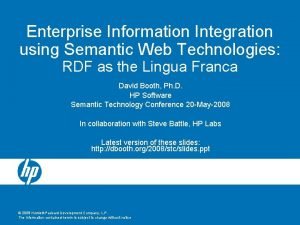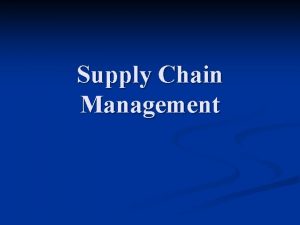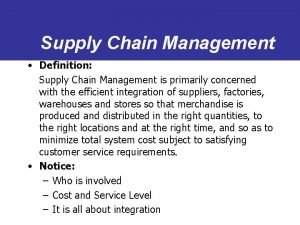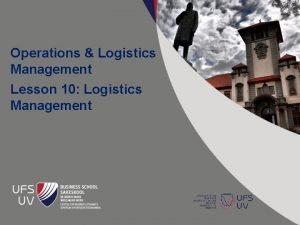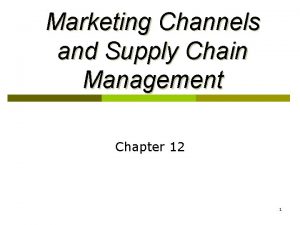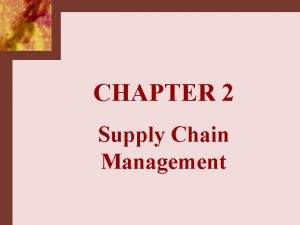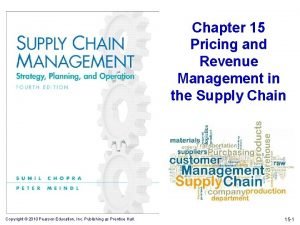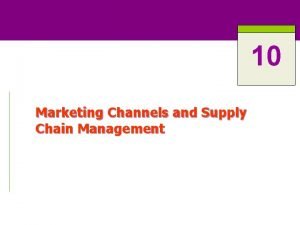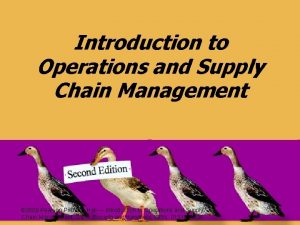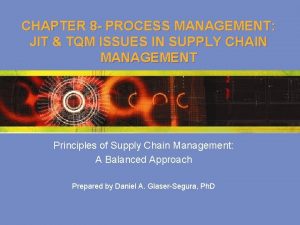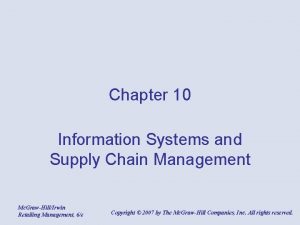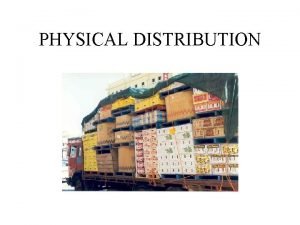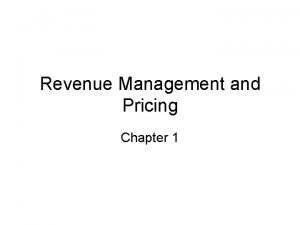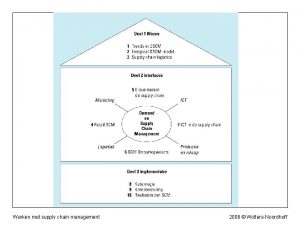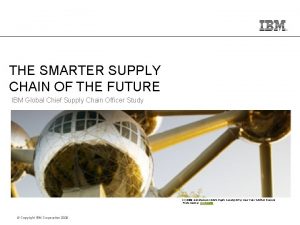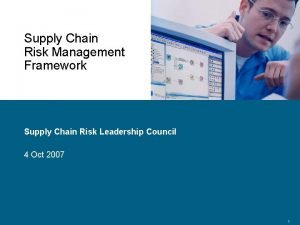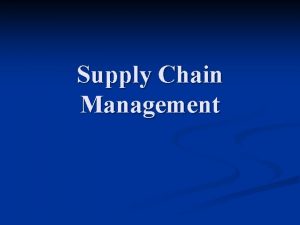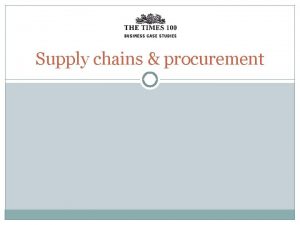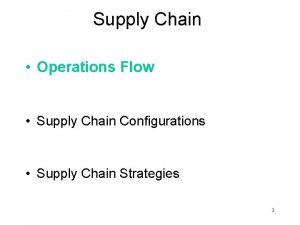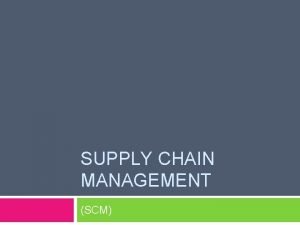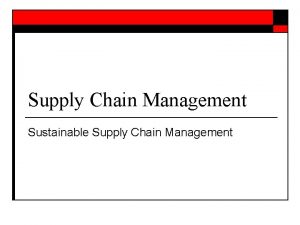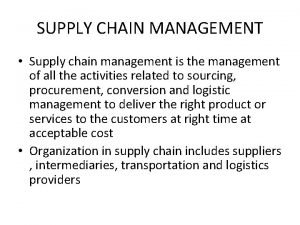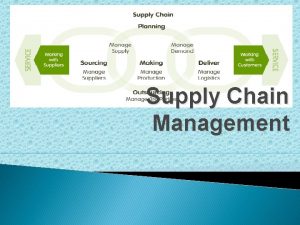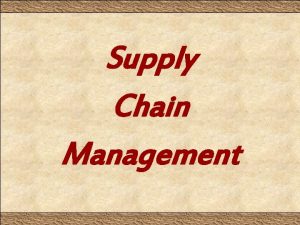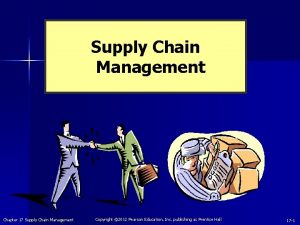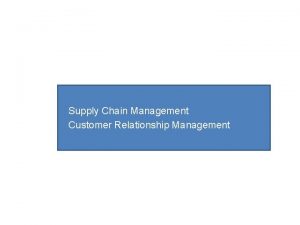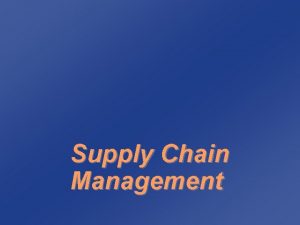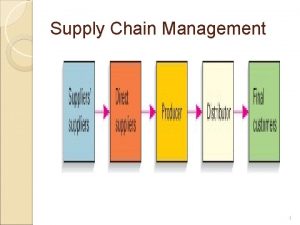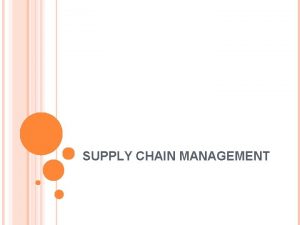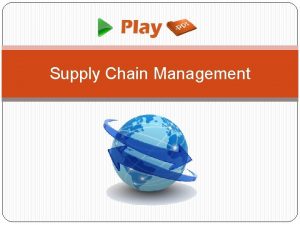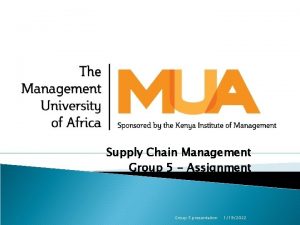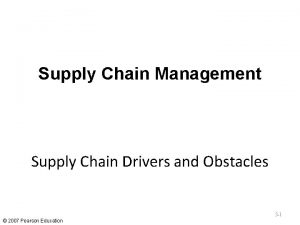Supply Chain Management technologies RFID and XML RFID





























- Slides: 29

Supply Chain Management technologies: RFID and XML

RFID: Radio Frequency Identification Reader (transmitter/receiver) Tags that respond to a radio frequency Transmits unique Identifier 8 -12 bytes (characters) at different frequency l Does not have to be line-of-sight l Lots of Applications Software Chapter 2 Principles of Information Systems, Fifth Edition Slide 2

Applications Check out: POS terminal Inventory tracking (Wal-Mart, Do. D) Animal tagging Secure car key (Toyota) Purchase gasoline (Mobil) Doorway access control Chapter 2 Principles of Information Systems, Fifth Edition Slide 3

Passive vs. active tags Passive tags Uses transmitter RF signal for power l Long lifespan l Costs start at about twenty cents l Low frequency: range is less than 6 inches l High frequency: range up to 12 inches l Ultrahigh frequency: several yards l Chapter 2 Principles of Information Systems, Fifth Edition Slide 4

Active tags Active tag Uses a battery to respond More range, up to 1 Km 3 -5 year battery life Can cost several dollars Chapter 2 Principles of Information Systems, Fifth Edition Slide 5

RFID quiz Q 1: What kind of tags are we using in lab? Q 2: Does the orientation of the tag affect the ability to read its contents? (try all of the tags) Q 3: Does placing a tag in a metal can affect the ability to read its contents? Q 4: Why is the flat tag Read/Write? Chapter 2 Principles of Information Systems, Fifth Edition Slide 6

RFID advantages Less human intervention Real-time information flow as item changes state: l l l Off truck Off shelf Purchased by customer Reduce lost or stolen inventory Machine-to-machine communication l Package routing Chapter 2 Principles of Information Systems, Fifth Edition Slide 7

RFID challenges Interference with object or other readers Range Data formats and standardization l Different countries allocate different frequencies Cost for readers, tags and system Chapter 2 Principles of Information Systems, Fifth Edition Slide 8

Bar Code vs. RFID scanning Line of sight Right-side-up (must physically align carton) Can tear Limited amount of data No encryption Chapter 2 Can read through objects Tag orientation less of a problem Can store megabytes of data, if needed Can be encrypted Principles of Information Systems, Fifth Edition Slide 9

Chapter 2 Principles of Information Systems, Fifth Edition Slide 10

Chapter 2 Principles of Information Systems, Fifth Edition Slide 11

UPC versus EPC Universal Product Code For Bar coding Contains MFR ID number (5 digits) and Item Number (5 digits) Electronic Product Code for RFID apps. Contains 96 bits: l l l EPC manager ID (MFR) Object class Serial number Can track a particular case of toothpaste ! Chapter 2 Principles of Information Systems, Fifth Edition Slide 12

RFID supply chain integration Supplier: Store EPC & pallet contents on DB EPC has supplier-ID and database key. Ship pallet with tag Chapter 2 Buyer /shipper: Pallet arrives automatically scanned for EPC Get contents from Supplier DB Principles of Information Systems, Fifth Edition Slide 13

RFID future RFID tag as a sensor l l Temperature: spoilage Package opened: drugs Larger memory: l l Car repair history Medical history Can we recycle RFID tags? l Chip-kill technology Privacy: track movement of people (ID card, EZPASS) or post-sale disposition of items. Chapter 2 Principles of Information Systems, Fifth Edition Slide 14

Supply Chain Management (SCM) Definition: A cross-functional inter-enterprise system that uses information technology to help support and manage the links between some of a company’s key business processes and those of its suppliers, customers, and business partners Chapter 2 Principles of Information Systems, Fifth Edition Slide 15

SCM Life Cycle Chapter 2 Principles of Information Systems, Fifth Edition Slide 16

Electronic Data Interchange (EDI) Definition: Involves the electronic exchange of business transaction documents over the Internet and other networks between supply chain trading partners Standard industry format to send RFQ, PO, Receiving notice, payment notice, Invoice, Payment remittance notice, etc. Now being replaced by Web and XML. Chapter 2 Principles of Information Systems, Fifth Edition Slide 17

EDI Activities Chapter 2 Principles of Information Systems, Fifth Edition Slide 18

SCM Planning Functions Supply Chain Design – optimize network of suppliers, plants, and distribution centers Forecasting customer demand by sharing demand supply forecasts instantaneously across suppliers and distributors Chapter 2 Principles of Information Systems, Fifth Edition Slide 19

SCM Execution Functions Materials Management – share accurate inventory and procurement order information, ensure materials required for production are available in the right place at the right time. Collaborative Manufacturing – optimize plans and schedules while considering resource, material, and dependency constraints Chapter 2 Principles of Information Systems, Fifth Edition Slide 20

SCM Execution Functions Collaborative Fulfillment –order management, vehicle scheduling, and support the entire logistics process, including picking, packing, shipping, and delivery in foreign countries Supply Chain Event Management – monitor every stage of the supply chain process, from price quotation to the moment the customer receives the product, and receive alerts when problems arise – visibility! Chapter 2 Principles of Information Systems, Fifth Edition Slide 21

Business Value of SCM Benefits of SCM: Reduces production and distribution costs l l More information => less inventory, less lead times needed Improves timeliness of shipments Increases supply chain “velocity” l More accurate fulfillment l Improves “visibility” of supply chain l Chapter 2 Principles of Information Systems, Fifth Edition Slide 22

SCM Benefits Fewer employees needed to manage supply chain Better customer satisfaction: less stock-outs Strategic relationship with suppliers, enables new business partnerships: l Collaborative Planning, Forecasting, and Replenishment systems (CPFR). l Collaborative downstream customer service, marketing, and relationship management. Chapter 2 Principles of Information Systems, Fifth Edition Slide 23

Technical Challenges of SCM Acquisition of secure extranet Software can be confusing, contradictory and not sculpted to their needs – difficult to implement. Emerging standards, high costs. Chapter 2 Principles of Information Systems, Fifth Edition Slide 24

Organizational challenges Changes company structure: resistance from employees wedded to traditional processes, leads to lack of adequate collaboration among marketing, production, and inventory management departments within a company Supplier reluctance or incompatibility issues. Lack of proper demand planning knowledge: leading to inaccurate or overoptimistic demand forecasts. Need new tools and guidelines. Chapter 2 Principles of Information Systems, Fifth Edition Slide 25

Fun with XML Standard way to describe structured data within an organization or across the Web (metadata included in file). Can check validity using a set of rules in a schema definition (xsd) file, using a validating XML parser. Chapter 2 Principles of Information Systems, Fifth Edition Slide 26

XML rules Each element tag is user-defined, within angle brackets: <purchase. Order> … </purchase. Order> Each element can have sub-parts: l <Address> <street> 515 Loudon Rd. </street> l <city> Loudonville </city> l l </Address> Chapter 2 Principles of Information Systems, Fifth Edition Slide 27

XML Schema definition file Rules besides “well-formed” XML: l Order of elements l l Data type: string, date or decimal l l <xsd: sequence> … </sequence> <xsd: element name=“zip” type=“xsd: decimal” /> Optional elements: l Chapter 2 min. Occurs=“ 0” Principles of Information Systems, Fifth Edition Slide 28

On Your Own Coors Case worksheet XML exercise Online quiz Chapter 2 Principles of Information Systems, Fifth Edition Slide 29
 Rfid definition supply chain
Rfid definition supply chain Ppt index
Ppt index Matching supply with demand
Matching supply with demand What is logistics management
What is logistics management Data integration with xml and semantic web technologies
Data integration with xml and semantic web technologies Types of ecrm
Types of ecrm Sequence in supply chain
Sequence in supply chain Grazing food chain diagram
Grazing food chain diagram Intraoperation scope
Intraoperation scope Logistics management introduction
Logistics management introduction Channel levels in marketing
Channel levels in marketing Marketing channels and supply chain management
Marketing channels and supply chain management Cscmp meaning
Cscmp meaning Role of pricing and revenue management in a supply chain
Role of pricing and revenue management in a supply chain Pricing and revenue management in a supply chain
Pricing and revenue management in a supply chain Exclusive vs selective distribution
Exclusive vs selective distribution Ford material
Ford material Introduction to operations and supply chain management
Introduction to operations and supply chain management Jit and tqm issues in supply chain management
Jit and tqm issues in supply chain management Vertical marketing
Vertical marketing Information system and supply chain management in retailing
Information system and supply chain management in retailing Component of physical distribution
Component of physical distribution Revenue management and pricing
Revenue management and pricing Global manufacturing and supply chain management
Global manufacturing and supply chain management Global logistics and supply chain management
Global logistics and supply chain management Werken met supply chain management
Werken met supply chain management Ibm supply chain strategy
Ibm supply chain strategy Supply chain risk management framework
Supply chain risk management framework Supply chain risk management framework
Supply chain risk management framework Supply chain cisco
Supply chain cisco




